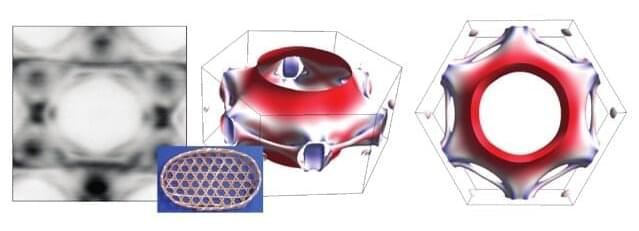Boson sampling was once considered a problem looking for a solution. Now, it might be the bridge that brings quantum computing to the blockchain.



An international research team has succeeded for the first time in measuring the electron spin in matter—i.e., the curvature of space in which electrons live and move—within “kagome materials,” a new class of quantum materials.
The results obtained—published in Nature Physics —could revolutionize the way quantum materials are studied in the future, opening the door to new developments in quantum technologies, with possible applications in a variety of technological fields, from renewable energy to biomedicine, from electronics to quantum computers.
Success was achieved by an international collaboration of scientists, in which Domenico Di Sante, professor at the Department of Physics and Astronomy “Augusto Righi,” participated for the University of Bologna as part of his Marie Curie BITMAP research project. He was joined by colleagues from CNR-IOM Trieste, Ca’ Foscari University of Venice, University of Milan, University of Würzburg (Germany), University of St. Andrews (UK), Boston College and University of Santa Barbara (U.S.).

Zuckerberg addressed Apple’s headset unveiling in a meeting with Meta employees, telling them that it ‘could be the vision of the future of computing, but like, it’s not the one that I want.’
Mark Zuckerberg doesn’t seem fazed by Apple’s introduction of the Vision Pro.
In a companywide meeting with Meta employees today that The Verge watched, the CEO said Apple’s device didn’t present any major breakthroughs in technology that Meta hadn’t “already explored” and that its vision for how people will use the device is “not the one that I want.” He also pointed to the fact that Meta’s upcoming Quest 3 headset will be much cheaper, at $499 compared to the Vision Pro’s $3,499 price tag, giving Meta… More.
One takeaway: “it costs seven times more.”

A chip-sized device can manipulate particles of sound in a way that mimics how particles of light are used in light-based quantum computers, opening the door for building sound-based quantum computers.
The Vision Pro is Apple’s bold entry into the world of spatial computing, and it seems like the company has learned a lot from the VR and AR headsets before it. The front of the device features an OLED screen that can display your eyes, making you more connected to the people in the real world. Its springy side bands and ribbed rear headband look like suitably high-end. And, simply put, it has the wow factor you’d expect from a prestige Apple product.
Still, there’s plenty of cause for concern. The required battery pack is a bit un-Apple, since you’ll have to stuff it into your pocket or find somewhere to store it. And we’ve yet to see someone wearing this headset in the real world. Apple’s event staff stressed that we couldn’t touch the Vision Pro or lean too close. And of course, we won’t see if Apple’s spatial computing vision lives up to its slick promotional videos until we can actually wear this thing.
At the very least, though, the Vision Pro makes me hopeful about the future of spatial computing. Recent headsets, like Sony’s PlayStation VR2 and the Meta Quest Pro, have made the limits of virtual reality very clear. They’re a bit too isolated from the real world, and they’re mainly focused on games. The Vision Pro, on the other hand, is a glimpse at a world beyond screens.

Apple’s Vision Pro headset is the company’s first new product category since the Apple Watch, and it is unlike any other Apple device. It runs an operating system called visionOS, and developers will need to create augmented and virtual reality apps specifically for the headset.
To ensure that there are a wide selection of experiences available at launch, Apple plans to provide Apple Vision Pro developer kits to developers at some point in the future.


Recently, the theory of Hawking radiation of a black hole has been tested in several analogue platforms. Shi et al. report a fermionic-lattice model realization of an analogue black hole using a chain of superconducting transmon qubits with tuneable couplers and show the stimulated Hawking radiation.

Black holes, cosmic power stations, fuel the luminosity of quasars and active galactic nuclei (AGNs) through their intricate interaction of matter, gravity, and magnetic forces. Despite black holes themselves not possessing a magnetic field, the surrounding dense plasma in the accretion disc does. As this plasma orbits the black hole, its charged particles generate an electric current and consequently a magnetic field.
This magnetic field, assumed to be stable due to the unvarying plasma flow, caused scientists to scratch their heads when they found evidence of its directional change. Such a phenomenon, known as a magnetic reversal, is akin to an imaginary pole of a magnet switching from north to south or vice versa. While not uncommon in stars, and even witnessed in the Sun’s 11-year sunspot cycle or Earth’s infrequent magnetic shifts, such an event was thought improbable for supermassive black holes.
In 2018, a computer-aided sky survey detected a startling transformation in a galaxy 239 million light-years away named 1ES 1927+654, which had suddenly become a hundredfold brighter. Swift Observatory soon reported x-ray and ultraviolet light emissions from this region. Initial speculations suggested a tidal disruption event caused by a star venturing too close to the galaxy’s central supermassive black hole, disrupting gas flow into the accretion disc, as the reason for this unusual luminosity.

The BEC phenomenon was first predicted by Satyendra Bose and Albert Einstein: when a given number of identical Bose particles approach each other sufficiently closely, and move sufficiently slowly, they will collectively convert to the lowest energy state: a BEC. This occurs when atoms are chilled to very low temperatures. The wavelike nature of atoms allows them to spread out and even overlap. If the density is high enough, and the temperature low enough (mere billionths of degrees above absolute zero), the atoms will behave like the photons in a laser: they will be in a coherent state and constitute a single “super atom.”
JILA’s Carl Wieman (University of Colorado, Boulder) and Eric Cornell (NIST) first started searching for a BEC around 1990 with a combination laser and magnetic cooling apparatus. Wieman pioneered the use of $200 diode lasers (the same type used in CD players) instead of the $150,000 lasers other groups were using. His approach was initially met with skepticism by his colleagues, but when he began to report real progress, several other groups joined the race to achieve the first BEC. Beginning with rubidium gas atoms at room temperature, the JILA team first slowed the rubidium and captured it in a trap created by laser light. This cooled the atoms to about 10 millionths of a degree above absolute zero—still far too hot to produce a BEC.
Once trapped, the lasers are turned off and the atoms are held in place by a magnetic field. The atoms are further cooled in the magnetic trap by selecting the hottest atoms and kicking them out of the trap. Then came the tricky part: trapping a sufficiently high density of atoms at temperatures that were cold enough to produce a BEC. To do this, Wieman and his colleagues had to devise a time-averaged orbiting potential trap (an improvement to the standard magnetic trap).